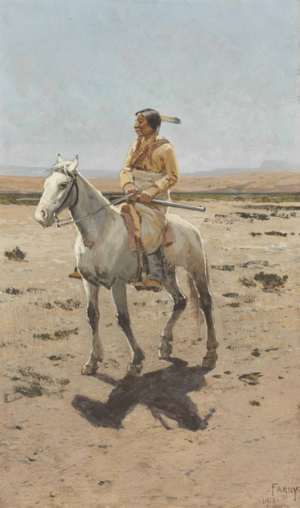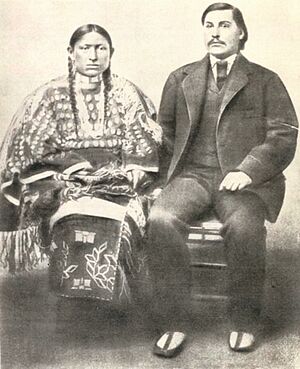Battle of Julesburg facts for kids
Quick facts for kids Battle of Julesburg |
|||||||
|---|---|---|---|---|---|---|---|
| Part of the Colorado War | |||||||
|
|||||||
| Belligerents | |||||||
| United States Army Civilian volunteers |
Cheyenne, Arapaho, and Lakota Native Americans | ||||||
| Commanders and leaders | |||||||
| Captain Nicholas J. O'Brien | Roman Nose, Spotted Tail, Pawnee Killer, Big Crow | ||||||
| Strength | |||||||
| 60 soldiers 50 armed civilians |
About 1,000 warriors | ||||||
| Casualties and losses | |||||||
| 14 soldiers killed 4 civilians killed |
Likely none | ||||||
The Battle of Julesburg happened on January 7, 1865. It was fought near Julesburg, Colorado. About 1,000 Cheyenne, Arapaho, and Lakota Native Americans fought against 60 U.S. Army soldiers and 40 to 50 civilians. The Native Americans won the battle. Over the next few weeks, they raided ranches and stagecoach stations. These places were located along the South Platte River valley.
Contents
Why the Battle Happened
The Sand Creek massacre happened on November 29, 1864. In this event, many Cheyenne and Arapaho people were attacked. This made many Native American groups on the Kansas and Colorado Great Plains very angry. They decided to fight back more strongly against the U.S. Army and white settlers.
On January 1, 1865, Native American leaders met. They gathered on Cherry Creek, near where St. Francis, Kansas is today. They planned how to get revenge. The meeting included the Cheyenne Dog Soldiers, the Northern Arapaho, and two groups of Lakota Sioux. These Sioux groups were the Brulé led by Spotted Tail, and the Oglala led by Pawnee Killer. Roman Nose was likely among the Cheyenne warriors. Their fighting force included about 1,000 warriors. They decided to attack Julesburg, Colorado. Julesburg was an important stop along the South Platte River.
About Julesburg and Fort Rankin
Julesburg was a key stop on the Overland Trail. It had a stagecoach station, stables, and an office for express mail and telegraph messages. There was also a large store for travelers going to Denver. About 50 armed men lived there. They had built sod walls to help them fight.
One mile west of Julesburg was Fort Rankin. This fort was later called Fort Sedgwick. It had about 60 soldiers, led by Captain Nicholas J. O'Brien. The fort was only four months old but was very strong. It measured about 240 by 360 feet (73 by 110 meters). It was surrounded by a sod wall 18 feet (5.5 meters) tall.
The Battle of Julesburg
The story of the Julesburg Battle is special. Most of what we know comes from the Native American side. Much of it was told by George Bent. He was a warrior who was half Cheyenne and half White. Bent later shared his story with anthropologists George Bird Grinnell and George E. Hyde.
The Native American plan was to trick the soldiers. They wanted to lure them out of Fort Rankin into an ambush. Big Crow, a Cheyenne warrior, chose ten men to act as decoys. These ten men rode quickly toward the fort. Then, they quickly rode away as if they were running.
Captain O'Brien led most of his soldiers and some civilian volunteers out of the fort. They chased after the Native American decoys. About three miles from the fort, O'Brien almost rode into the ambush. But some young Native American warriors fired their weapons too soon. This warned O'Brien that many warriors were hiding behind nearby hills.
The soldiers quickly turned and fled back toward the fort. The Native Americans chased them. They caught up about 300 yards (274 meters) from the fort. Some soldiers were cut off from the main group. They got off their horses to defend themselves but were killed. The soldiers and civilians who survived, including Captain O'Brien, made it back to safety inside the fort. In the battle, 14 soldiers and 4 civilians were killed. George Bent said no Native Americans were killed or hurt. However, the soldiers claimed they killed about 60.
All the civilians in Julesburg were safe inside the fort. The Native Americans were unopposed outside. They looted the stage station, the store, and the warehouse. They took away many valuable items. The soldiers inside the fort fired a few cannon rounds at the Native Americans, but it had no effect.
After the Battle
After the attack, General Robert Byington Mitchell gathered his forces. He had 640 cavalry soldiers, cannons, and 200 supply wagons. He started at Cottonwood Springs, near where North Platte, Nebraska is today. He marched southwest to find the Native Americans who attacked Julesburg.
On January 19, he found their camp on Cherry Creek. But the Native Americans had already left several days before. More than 50 of Mitchell's soldiers got frostbite because of the very cold weather. So, Mitchell stopped chasing them and went back to his base. The only action during his trip was when a small group of Native Americans rode through his camp at night. They fired into the soldiers' tents.
The Sioux, Cheyenne, and Arapaho groups decided to move north. They headed toward the Black Hills and Powder River Country in South Dakota and Wyoming. As they traveled, from January 28 to February 2, they raided ranches and stagecoach stations. These raids happened along 150 miles (240 km) of the South Platte Valley. This area is between what are now Fort Morgan, Colorado and Paxton, Nebraska. The Sioux raided east of Julesburg. The Cheyenne raided west of Julesburg. The Arapaho raided in between. George Bent said that at night, "the whole valley was lighted up with the flames of burning ranches and stage stations." But soon, all the places were destroyed, and darkness returned.
Bent also took part in a raid near the Valley stagecoach station. This was close to present-day Sterling, Colorado. The Cheyenne captured 500 cattle. They also had a small fight with a company of army cavalry. The army said they killed 20 Native Americans and got the cattle back. But Bent said no Native Americans were hurt. He said two soldiers were wounded, and only a few cattle were taken back by the soldiers. Most of the Native American raids were not stopped. However, three Sioux warriors were killed when they attacked a wagon train. Bent also noted that nine soldiers who had recently left the army were killed by the Cheyenne. These soldiers had been part of the Sand Creek massacre.
On February 2, the large group of Native Americans moved north. This group included thousands of women, children, and livestock. They crossed the frozen South Platte River about 25 miles (40 km) west of Julesburg. The warriors raided Julesburg again. They took the remaining supplies and burned all the buildings. The 15 soldiers and 50 civilians inside Fort Rankin did not leave the fort's walls.
Captain O'Brien and 14 men had been away from the fort. They returned during the raid. Smoke from the fires hid their presence for a while. As they got closer to the fort, O'Brien fired his field howitzer. This scattered the Native Americans. The men in the fort fired another howitzer to help him. O'Brien and his men quickly ran to safety inside the fort.
The Sioux led the way because they knew the route better. The Native Americans left Julesburg behind. They continued north across the land between the South Platte and North Platte rivers. They would have more fights with the army. These skirmishes happened at Mud Springs (near Dalton, Nebraska) and Rush Creek.
Images for kids




